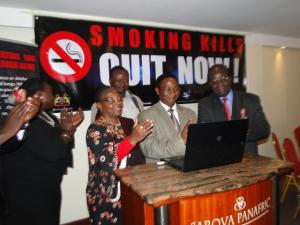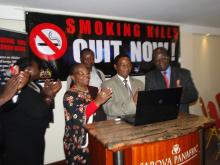Kenya Launches a National anti-Smoking Mass Media Campaign
Kenya has launched a national anti-smoking mass media campaign with a call to end tobacco use, protect lives from second hand smoke exposure and educate the public about the dangers of smoking.
The campaign, dabbed ‘Tobacco Kills – Quit Now,’ was launched amidst recent Global Adult Tobacco Survey (GATS) findings which have shown that 1.7 million Kenyan adults smoke tobacco and 3.1 million (14.3 per cent) are exposed to it through second hand smoke at home. The findings also show that 86.1% of adults (3.1 million) are exposed to tobacco smoke when visiting bars or nightclubs and 0.5 million adults (30.2% of adults) are exposed to tobacco smoke when visiting universities. Another 2.1 million are exposed to tobacco smoke when visiting restaurants. The survey also shows that over three quarters (77.4%) of current smokers planned to or were thinking about quitting. The main source of cigarette purchase for Kenya males is shops (65.0%) and Kiosks (30.9%).
The four-month campaign includes radio and TV messages in English, Swahili and local languages for listeners and viewers around the country. It also includes community posters that will be placed in schools, universities and other public institutions.
Speaking at the launch, the WHO Country Representative Dr Custodia Mandlhate said the full addictiveness of tobacco and the full range of health dangers had not been adequately explained to the public.
“Many tobacco users cannot name specific diseases caused by smoking other than lung cancer, and do not know that smoking also causes heart disease, stroke and many other diseases, including many types of cancer.
She said people needed to associate tobacco with its extreme addictiveness and dangerous health consequences, and to see it as socially undesirable and negative.
She commended the Kenyan government for the effort it had made and for the campaign and pledged WHO support for the government’s effort to reduce and eventually stamp out tobacco use and exposure in the country. She cited the sentiments of Dr. Margaret Chan, the WHO Director General which state: "We hold in our hands the solution to the global tobacco epidemic that threatens the lives of one billion men, women and children during this century. “
Dr Jackson Kioko, head, directorate of preventive and promotive health services, Ministry of Health, called on the participation of stakeholders and the public to help redress the problem and create a tobacco-free environment.
Speaking on behalf of the MOH principal secretary Dr Khadija Kassachoon, Dr Kioko noted that the findings of the study were an indication of the depth of the problem and the need to avert deaths from needles diseases associated with smoking. These include lung disease, heart diseases and cancers.
He acknowledged the key role played by journalists and called on them to play the interventional role in the campaign. He noted that smoking had been used as an initiation for youth into adulthood through peer pressure and said the campaign would be useful in creating awareness among youth and the general public and in behavior change among smokers.
Prof Peter Odhiambo, chairman of the Tobacco Control Board said Kenya had taken a lead towards banning of tobacco smoking and had initiated legislation, a strategic and operational plan.
Kenya ratified the WHO Framework Convention on Tobacco Control (FCTC) in 2004 and through the Tobacco Control Act 2007 provides control measures including a ban on smoking in public places, direct and indirect advertising and a ban of sale of tobacco products to and by minors.
He however cautioned that the tobacco industry in Kenya was also making great effort to sustain the industry and called on the youth and the public not to ignore the warning against smoking and other NCDs.
He noted the first heart attack in Kenya was recorded in 1959 and until the 1960s high pertension had not been known in the country. NCDs only became a reality in 1960s because of imitating a lifestyle from without the country, he said.
Mr Vincent Kimosop, CEO, Institute of Legislative Affairs, said about 10 per cent of Kenyan youth (9.9 %) aged 13-15 are tobacco users. He commended the campaign stating it would support the legislation for a smoke free environment at home and in public places where children are exposed alongside adults.
Dr Mandlhate also reiterated the six practical and achievable measures and policies intended to control tobacco. She said the policy package could reverse the tobacco epidemic and prevent millions of tobacco-related deaths. The measures also known as MPOWER include:
Monitor tobacco use and prevention policies,
Protect people from tobacco smoke,
Offer help to quit tobacco use,
Warn about the dangers of tobacco,
Enforce bans on tobacco advertising, promotion and sponsorship, and
Raise taxes on tobacco
The launch is also supported by World Lung Foundation, Tobacco Control Board, the National Campaign against Drug Abuse, NACADA, and Kenya Tobacco Control Alliance.
____________________________________
For Further Information, Please Contact:
WHO Kenya Country Office
Email: afkenwr [at] who.inttarget="_blank"
4th Floor ACK Garden House, 1st Ngong Avenue Off Bishops Road
P.O. Box 45335, 00100(GPO)
Nairobi, Kenya






